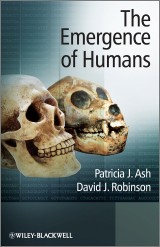Details

The Emergence of Humans
An Exploration of the Evolutionary Timeline1. Aufl.
|
55,99 € |
|
| Verlag: | Wiley |
| Format: | |
| Veröffentl.: | 16.03.2010 |
| ISBN/EAN: | 9780470682883 |
| Sprache: | englisch |
| Anzahl Seiten: | 338 |
DRM-geschütztes eBook, Sie benötigen z.B. Adobe Digital Editions und eine Adobe ID zum Lesen.
Beschreibungen
<i>The Emergence of Humans</i> is an accessible, informative introduction to the scientific study of human evolution. It takes the reader through time following the emergence of the modern human species <i>Homo sapiens</i> from primate roots. Acknowledging the controversy surrounding the interpretation of the fossil record, the authors present a balanced approach in an effort to do justice to different views. <p>Each chapter covers a significant time period of evolutionary history and includes relevant techniques from other disciplines that have applications to the field of human evolution. Self-assessment questions linked to learning outcomes are provided for each chapter, together with further reading and reference to key sources in the primary literature. The book will thus be effective both as a conventional textbook and for independent study.</p> <p>Written by two authors with a wealth of teaching experience <i>The Emergence of Humans</i> will prove invaluable to students in the biological and natural sciences needing a clear, balanced introduction to the study of human evolution.</p>
Preface. <p>Introduction.</p> <p><b>1 The first human fossils.</b></p> <p>1.1 Summary.</p> <p><b>2 The geological context.</b></p> <p>2.1 The geological time scale.</p> <p>2.2 Movement of the continents.</p> <p>2.3 Fossilization.</p> <p>2.4 Dating.</p> <p>2.5 Dating techniques.</p> <p>2.6 Habitats and environment.</p> <p>2.7 Climate changes and long term cycles.</p> <p>2.8 Summary.</p> <p><b>3 Evolution and natural selection.</b></p> <p>3.1 Darwin and the origin of species by natural selection.</p> <p>3.2 The modern synthesis of evolution.</p> <p>3.3 Inheritance of characters.</p> <p>3.4 Population genetics.</p> <p>3.5 Geographic isolation and speciation.</p> <p><b>4 65-40 Mya: Primate and arthropoid origins.</b></p> <p>4.1 The Scadentia and Plesiadapiformes.</p> <p>4.2 The emergence of primates.</p> <p>4.3 Ancient primates.</p> <p>4.4 Dentition of ancient primates.</p> <p>4.5 The most ancient arthropoid?</p> <p>4.6 Evolutionary relationships of Adapiformes, Omomyiformes and Arthropoids.</p> <p>4.7 Classification of primates.</p> <p>4.8 Summary.</p> <p><b>5 40-8 Mya: Arthropoids and humanoids.</b></p> <p>5.1 Introduction.</p> <p>5.2 Radiation of the Arthropoids and other primates.</p> <p>5.3 Use of cladistics for identifying evolutionary relationships in primate groups.</p> <p>5.4 Social structures in primate groups.</p> <p>5.5 The hominoidea.</p> <p>5.6 Conclusion.</p> <p><b>6 8-4.4 Mya: Who were the ancestors of the hominins?</b></p> <p>6.1 The first hominin: Toumai?</p> <p>6.2 The first hominin: Orrorin?</p> <p>6.3 Another first hominin: Ardipithecus kadabba.</p> <p>6.4 Ardipithecus ramidus.</p> <p>6.5 An un-named hominin from Lothagam.</p> <p>6.6 Evolutionary relationships of the early hominins.</p> <p>6.7 Conclusion.</p> <p><b>7 4.2-3.0 Mya: Adaptive radiation of hominins.</b></p> <p>7.1 The Australopiths.</p> <p>7.2 The first Australopiths: Australopithecus anamensis.</p> <p>7.3 Australopithecus afarensis; a possible ancestor of Homo?</p> <p>7.4 The flat-faced skull from Kenya.</p> <p>7.5 Australopithecus Africanus.</p> <p>7.6 Sterkfontein and the 'Little Foot' discovery.</p> <p>7.7 Conclusion.</p> <p><b>8 3.0-1.0 Mya: Emergence and diversification of the genus.</b></p> <p>8.1 The robust Australopiths.</p> <p>8.2 Paranthropus boisei.</p> <p>8.3 Paranthropus aethiopicus.</p> <p>8.4 Australopithecus garhi.</p> <p>8.5 Tools and tool technologies.</p> <p>8.6 Australopiths in the human lineage.</p> <p>8.7 Early Homo.</p> <p>8.8 Homo habilis and Homo rudolfensis.</p> <p>8.9 Homo rudolfensis and Kenyanthropus platyops.</p> <p>8.10 Radiation of Homo species.</p> <p>8.11 Homo ergaster and Homo erectus.</p> <p>8.12 Did Homo erectus return to Africa?</p> <p>8.13 Conclusion.</p> <p><b>9 1.0 Mya: 700 000 years ago.</b></p> <p>9.1 Introduction.</p> <p>9.2 Persistence of Homo erectus in Africa and East Asia.</p> <p>9.3 Homo antecessor in Spain.</p> <p>9.4 The Ceprano hominin calvaria.</p> <p>9.5 Conclusion.</p> <p><b>10 700 00 ya.-130 000 ya: Emergence of new species of Homo.</b></p> <p>10.1 Introduction.</p> <p>10.2 The emergence and migration of Homo heidelbergensis.</p> <p>10.3 The discovery of Neandertals.</p> <p>10.4 The emergence of modern Homo sapiens.</p> <p>10.5 Conclusion.</p> <p><b>11 130-10 000 years ago: Homo sapiens out of Africa.</b></p> <p>11.1 Introduction.</p> <p>11.2 The role of genetic studies.</p> <p>11.3 Studying artifacts.</p> <p>11.4 Modern Homo sapiens in Africa.</p> <p>11.5 Neandertals and modern Homo sapiens in Western Africa and Middle East.</p> <p>11.6 Neandertals and modern Homo sapiens in Europe.</p> <p>11.7 Modern humans and Neandertals in Central Asia.</p> <p>11.8 South East Asia and Australasia.</p> <p>11.9 A new species of Homo?</p> <p>11.10 East Asia.</p> <p>11.11 Modern humans arrive in the Americas.</p> <p>11.12 Conclusion.</p> <p><b>12 Coda.</b></p> <p>Glossary.</p>
"But few current volumes offer the flexibility inherent in the sheer comprehensiveness of The Emergence of Humans. In this remarkably compact volume, Ash and Robinson, both of whom teach at the U.K.'s Open University, cover (in varying depth) virtually everything that a focused course in this subject might want to address, while avoiding related areas of anthropology." (The Quarterly Review of Biology, 1 March 2011) <p>"The Emergence of Humans is an accessible, informative introduction to the scientific study of human evolution. . . written by two authors with a wealth of teaching experience The Emergence of Humans will prove invaluable to students in the biological and natural sciences needing a clear, balanced introduction to the study of human evolution. Recommendation: would make a good undergraduate level textbook." (The Birdbooker Report, 16 November 2010)<br /> "</p>
<p><strong>Dr. Patricia J. Ash</strong>, The Open University in the South, UK and <strong>Dr. David J. Robinson<.strong>, Department of Life Sciences, The Open University, UK.
<i>The Emergence of Humans</i> is an accessible, informative introduction to the scientific study of human evolution. It takes the reader through time following the emergence of the modern human species <i>Homo sapiens</i> from primate roots. Acknowledging the controversy surrounding the interpretation of the fossil record, the authors present a balanced approach in an effort to do justice to different views. <p>Each chapter covers a significant time period of evolutionary history and includes relevant techniques from other disciplines that have applications to the field of human evolution. Self-assessment questions linked to learning outcomes are provided for each chapter, together with further reading and reference to key sources in the primary literature.</p> <p>Written by two authors with a wealth of teaching experience <i>The Emergence of Humans</i> will prove invaluable to students in the biological and natural sciences needing a clear, balanced introduction to the study of human evolution.</p>

















